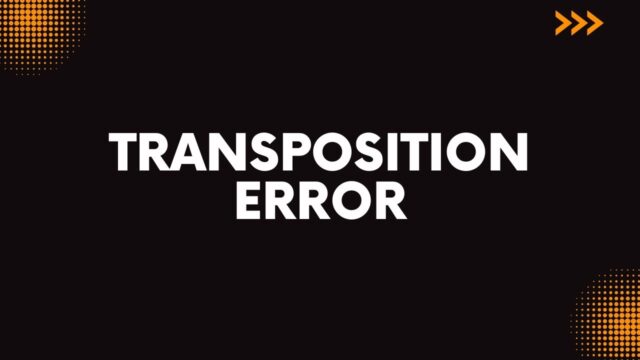
A transposition error occurs when one or more consecutive digits is substituted for another. The error can occur for several reasons, but usually involves two consecutive digits. A person who has to manually enter data often has this problem. Even a small transposition error can lead to serious mistakes in tax returns. However, there is no single indicator that will catch all transposition errors. Here are some warning signs to watch out for when it comes to transposition errors.
Transposition error causes by substituting two (or more) sequential digits
A transposition error occurs when two consecutive digits are swapped, resulting in a difference that is not evenly divisible by nine. For example, you may enter the number 18 as 3626, but you actually mean to write the number as nine. If you want to be certain that the difference is indeed divisible by nine, check that it is a number divisible by thirteen.
Another type of transposition error is where the reversed order of two consecutive digits causes significant inconsistencies. A bookkeeper may accidentally transfer an invoice number to the balance sheet when they are recording the invoice. In the same manner, a check might be incorrectly filled out, resulting in an overdraft. Additionally, transportation errors can lead to inaccurately-recorded customer profiles. Finally, transposition errors can lead to catastrophic consequences, especially if they happen to involve medicinal dosing.
Nontransposition error pattern
A transposition error occurs when the first two digits of a number are switched, creating a difference that is evenly divisible by nine. The difference between 986 and 968 is 18, which is also a prime number. A nontransposition error pattern in transposition error can be described by similar examples. For example, when we record 3662 as 3626, we have a transposition error.
The likelihood of nontransposition is increased by the level of unemployment in the country. A two-percent increase in unemployment leads to a 78 percent chance of a directive not being transposed on time. Likewise, a one-percent rise in unemployment leads to a 67-percent chance of nontransposition. The unemployment rate continues to rise, reaching three percent. These are all risk factors that could be used to determine the optimal time to transpose a directive.
Signs of a transposition error
Transposition errors in math can be very troublesome. The problem arises when an individual is unable to retain the correct order of digits in a calculation. These errors can result in catastrophic financial results, or in the death of a person. Transposition errors affect the aorta and pulmonary arteries, which are both major blood vessels that leave the heart. When this happens, the aorta begins in the right ventricle, while the pulmonary artery begins in the left ventricle.
In math, transposition errors are the result of a person mistakenly recording two adjacent digits in the wrong order. The difference between 986 and 968 is evenly divisible by nine, which indicates the transposition error. In the example above, the bookkeeper entered 56 instead of 65. In this example, the wrong number will be evenly divisible by nine, and the correct number will be 36. The difference is evenly divisible by nine.
Traceability of a transposition error
A transposition error is when a number is recorded as two opposite digits instead of one. The transposition error can be traced to an exact digit by recording the correct digit as the incorrect one. This error is easily detectable because the difference between the two numbers is evenly divisible by nine. Therefore, the amount of the transposition error is always divisible by nine. Therefore, there is no doubt that it exists.
A transposition error can occur on any number, whether it is in a journal entry, business ledger, financial statement, or invoice. Transposition errors are not limited to accounting books, however. Businesses can make them while writing down customer information, and individuals can make them in emails. Regardless of the source, there is always a chance of transposition errors in an accounting book. However, if you do not catch these mistakes in time, they can affect your financial situation.
Costs of a transposition error
Transposition errors happen when a bookkeeper accidentally reverses two adjacent digits. These errors have significant financial consequences and often lead to overdrafts and other problems. They are most commonly seen in brokerages, accounting firms, and other financial service providers. While most transposition errors are caused by human error, they can also have catastrophic consequences. Here are the main costs of transposition errors. These costs may be substantial depending on the size of your business.
Transposition errors are common errors in data entry. They can be committed by humans or by optical character recognition programs. Because transposition errors create an imbalance between debits and credits, it is difficult to spot them in accounting records. To determine whether a transposition error has occurred, divide the original data by nine. For example, if the data on two sides of an account are transposed, the $900 difference will be evenly divisible by nine, and there will be no remainder.


































